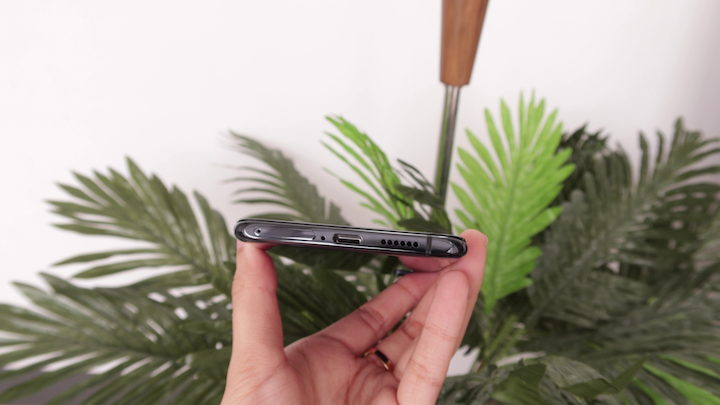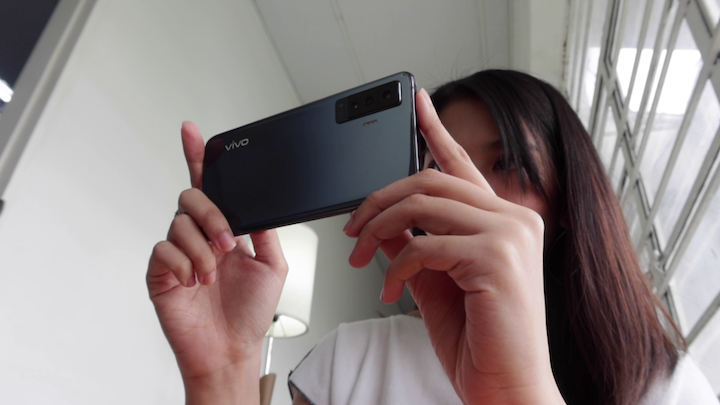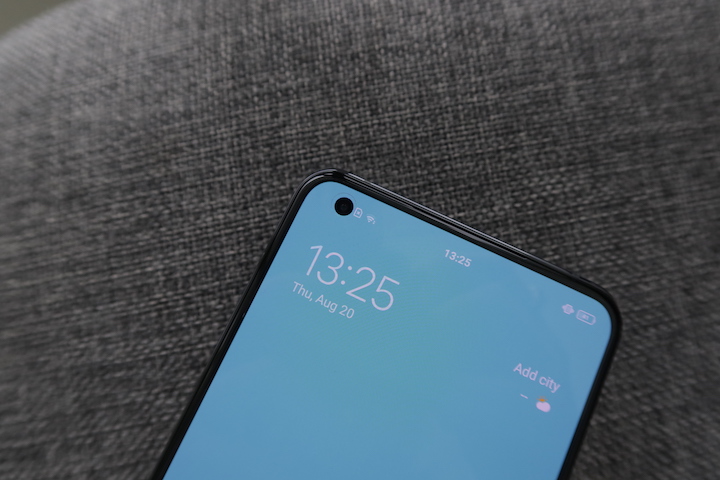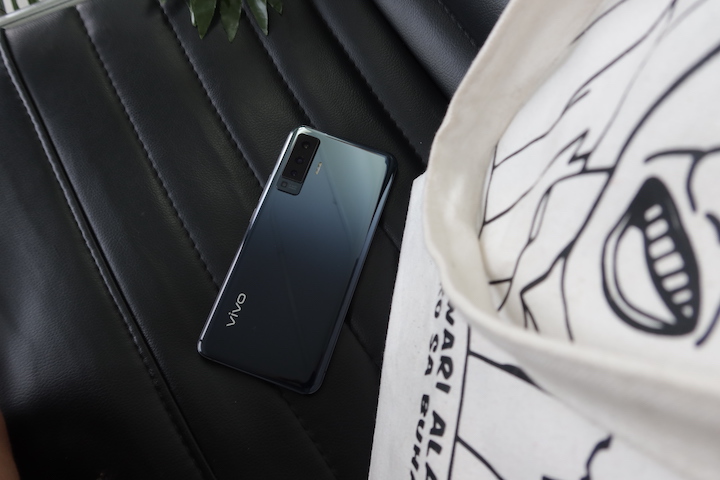More and more smartphone manufacturers are releasing their premium mid-rangers. There’s the OnePlus Nord, the Huawei Nova 7 5G, and the OPPO Reno4, to name a few. From vivo, we have the vivo X50. With the spotlight more focused on its Pro version, how does the standard vivo X50 fare? Find out in our review.

Table of Contents
Right off the bat, the vivo X50 shares the same style and size as the X50 Pro. The unit we have is in the Glaze Black colorway, and it looks modern and premium with its glass back and reflective mirror gradient design. It’s subtle but looks very sleek. However, it’s also quite a fingerprint magnet, but you can also opt for the Frost Blue variant that has a matte finish on it.

The back keeps a vertically aligned protruding quad-rear camera module with the LED flash and color temperature beside it. If we look a little closer, we’ll see a tiny third microphone underneath the camera module. Other than that, we get some vivo branding here. The camera bump is a little thick, making the phone wobble when placed on surfaces.

Upfront, we get a 6.56-inch AMOLED display and a hole-punch cut-out that houses its front-facing camera. On top of that is a receiver, and we’ll also find on-screen its in-display fingerprint scanner.

There are no buttons on the left side while the right side houses the volume rocker and the power button.

Up top, we have a secondary microphone and a small text that says, “Professional Photography.”

We get its loudspeaker, USB Type-C port, primary microphone, and a dual Nano SIM-card tray underneath the device. There’s no expandable storage via a microSD card.

In hand, the X50 comes with a little heft, but holding it feels comfortable. However, users with small hands might have to use both hands to reach the screen’s top.
More on its display, the vivo X50 inherits the same display as the Pro version. That’s a 6.56-inch AMOLED screen with a resolution of 2376 x 1080px, and a pixel density of 398ppi. It is also worth mentioning that the display supports HDR10+ and has a 90Hz refresh rate option.
Expectedly, its display experience is excellent. With an AMOLED panel, we get vibrant colors and deep blacks. Plus, with the 90Hz refresh rate on, navigating the screen is buttery smooth. Keeping the display in Standard mode already looks vivid, but you can change it to Bright mode in the settings to make it look more vibrant.

The punch hole front camera is placed a little odd, we would’ve preferred to see it a little closer to the upper left corner, but then again, it’s not that distracting. Unfortunately, there’s no option to hide the punch-hole, but you can control specific apps if you want to maximize the whole display or not.
When it comes to audio, sound quality from the down-firing loudspeaker is pretty decent. It’s suitable for casual use, and gaming, and turning the volume to max doesn’t sound too tinny. Since there’s no 3.5mm audio port in sight, there’s a headphone jack to USB Type-C adapter to compensate in the package together with some regular earphones the company supplied out of the box.
One of the notable features of the X50 is its cameras. It comes with a quad-camera setup consisting of a 48MP Sony IMX598 primary shooter, a 13MP depth, an 8MP Super-wide angle, and a 5MP Macro lens. On its punch hole reside a 32MP front shooter.

If you’re used to vivo’s interface, then its camera app should be familiar to you. Nonetheless, if you’re new to it, we can say that you can quickly go around it with its easy-to-navigate look.
For photo quality, the standard mode noticeably produces clear and sharp images even when you’re not using the 48MP lens. We get good colors, especially under good lighting scenarios. And we found the super-wide-angle lens very useful to capture more range.
When it comes to selfies, you can expect bright and well-detailed portraits with some subtle post-processing going on even when beauty mode is turned off. You can adjust the aperture manually with the portrait mode, and you can expect good subject-background separation that can struggle in certain situations depending on how intense you set the bokeh effect.
And when it comes to videos, you can shoot up to 4k at 60fps with EIS, and we appreciate how you can use the super-wide-angle lens with it. Using the standard video size allows you to toggle from normal to 2x zoom in one shot.
Quality-wise, videos on the X50 has excellent stabilization and quick focusing. It may not be as good as the Pro version in this department, but this should be good enough for vlogging or other video needs on the go.
The X50 runs on the latest Android 10 skinned with Funtouch 10.5. This UI looks familiar at the same time, refreshing to see if you’ve used older vivo smartphones. The quick shortcuts are accessible together with the notifications by scrolling down from the top of the display. And you can navigate with the usual buttons or purely with gestures too.

There’s an app drawer option in the settings and this being vivo, expect it to be highly customizable with a lot of quirky features you can play around. There are some bloatware and pre-installed apps, including Google apps, Lazada, Opera, Facebook, Kumu, and GCash, but you can always uninstall them if you don’t plan on using them.

For other features, it has Jovi, which is vivo’s AI assistant, that works within the phone’s other features like the home screen, cameras, even with game apps, to provide the user a better experience. There’s also Ultra Game Mode to boost your gaming use with features such as Esports mode, picture-in-picture, frame-rate priority, 4D game vibration, and block notifications.
Other features that can be found in the settings are dark mode, app clone, digital well-being, and dynamic effects for more animations.
Out of the 128GB storage, we were left with a usable space of 110GB.
Powering the X50 is a Qualcomm Snapdragon 730 paired with an Adreno 618 GPU, 8GB of RAM, and 128GB of internal storage. And as a premium midrange device, we get a smooth performance without any stuttering.

We didn’t experience any lags or crashes while using the device for a long time– be it for gaming, navigating, taking photos, or social media browsing. With that huge RAM, apps launch fast, and multitasking is a breeze. It doesn’t heat up quickly when using the 90Hz refresh rate for a long period.
Take a look at the benchmark scores we got:
• AnTuTu V8.4.1 – 281,494
• Geekbench – 545 (Single-Core), 1,741 (Multi-Core)
• 3DMark SSE – 2,246 (OpenGL ES 3.1), 2,071 (Vulkan)
• PCMark – 8,270 (Work 2.0)
• AndroBench – 502.06 MB/s (Seq. Read), 216.07 MB/s (Seq. Write)
For biometrics and security, it comes with an in-display fingerprint scanner and face recognition. Both scanners are snappy and accurate. We also like that there are fun animations for the in-display fingerprint scanner for you to choose from.
Now for connectivity, the X50 is packed with the usual, including WiFi 6, Bluetooth 5.1, Multi-function NFC, and GPS. Sadly, locally, only the Pro version of the X50 is equipped with 5G connectivity, so we’re only getting 4G LTE for the standard version.

Giving power to the X50 is a pretty decent 4,200mAh battery with 33W vivo FlashCharge 2.0, which is fast and can charge the device for more or less than an hour. On average, we were able to use the device for a day or a day and a half when using the standard 60Hz refresh rate. With the 90Hz refresh rate on, it can manage a whole day with light usage and occasional gaming.
In our standard video loop test, where we keep a 1080p movie on loop with 50% brightness, 0% volume, and airplane mode turned on, the device lasted for 20 hours and 15 minutes. We also ran it through PCMark’s Battery Test, and the X50 yielded a score of 12 hours and 59 minutes.
The vivo X50 has an SRP of PHP 25,999, and with that, you get 8GB of RAM and 128GB of internal storage that’s sadly non-expandable. It’s PHP 4,000 less than the pro version, and significantly trimmed down aspects applied are the lack of that superb video performance, 5G connectivity, a slightly lower battery capacity, and a lower chipset, which by the way, still delivers smoothly.

We don’t have many complaints about it, except for the price. With the current competition in the market, the X50 might get a hard time being on top of the mind for most users looking at premium midrange phones. Then again, if you’re interested in the X50, you don’t have to worry about performance and cameras. It’s great for media consumption with its outstanding display with a 90Hz option, and charging is a breeze with its 33W fast charging tech.
vivo X50 specs:
6.56-inch FHD+ (2376 x 1080) AMOLED 90Hz display
HDR10+
Corning Gorilla Glass
Qualcomm Snapdragon 730 octa-core CPU
Adreno 618 GPU
8GB LPDDR4X RAM
128GB UFS 2.1
Quad-rear cameras:
48MP Sony IMX598 F1.6 four-axis OIS (main)
13MP F2.48 (portrait)
8MP F2.2 (wide-angle)
5 MP 2.48 (macro)
32MP F2.45 front camera
Dual-SIM (nano)
4G LTE
WiFi 6
Bluetooth 5.0
Multi-function NFC
GPS, BeiDou, GLONASS, Galileo
Fingerprint scanner (in-display)
Face unlock
Jovi
USB Type-C
Funtouch OS 10.5 (based on Android 10)
4,200mAh battery w/ 33W Vivo FlashCharge 2.0
159.54 x 75.39 x 7.55mm
173g
Frost Blue, Glaze Black
With inputs from Justine Basco

YugaTech.com is the largest and longest-running technology site in the Philippines. Originally established in October 2002, the site was transformed into a full-fledged technology platform in 2005.
How to transfer, withdraw money from PayPal to GCash
Prices of Starlink satellite in the Philippines
Install Google GBox to Huawei smartphones
Pag-IBIG MP2 online application
How to check PhilHealth contributions online
How to find your SIM card serial number
Globe, PLDT, Converge, Sky: Unli fiber internet plans compared
10 biggest games in the Google Play Store
LTO periodic medical exam for 10-year licenses
Netflix codes to unlock hidden TV shows, movies
Apple, Asus, Cherry Mobile, Huawei, LG, Nokia, Oppo, Samsung, Sony, Vivo, Xiaomi, Lenovo, Infinix Mobile, Pocophone, Honor, iPhone, OnePlus, Tecno, Realme, HTC, Gionee, Kata, IQ00, Redmi, Razer, CloudFone, Motorola, Panasonic, TCL, Wiko
Best Android smartphones between PHP 20,000 - 25,000
Smartphones under PHP 10,000 in the Philippines
Smartphones under PHP 12K Philippines
Best smartphones for kids under PHP 7,000
Smartphones under PHP 15,000 in the Philippines
Best Android smartphones between PHP 15,000 - 20,000
Smartphones under PHP 20,000 in the Philippines
Most affordable 5G phones in the Philippines under PHP 20K
5G smartphones in the Philippines under PHP 16K
Smartphone pricelist Philippines 2024
Smartphone pricelist Philippines 2023
Smartphone pricelist Philippines 2022
Smartphone pricelist Philippines 2021
Smartphone pricelist Philippines 2020
Rene Imperio Jr says:
Guys medyo may mali ata.
Performance and Benchmarks
Powering the X50 is a Qualcomm Snapdragon 730 paired with an Adreno 618 GPU, 8GB of RAM, and 128GB of internal storage
vivo X50 specs:
6.56-inch FHD+ (2376 x 1080) AMOLED 90Hz display
HDR10+
Corning Gorilla Glass
Qualcomm Snapdragon 765G octa-core CPU
Adreno 620 GPU
8GB LPDDR4X RAM
128GB, 256GB UFS 2.1
Louie Diangson says:
Hi Rene, thanks for bringing this up. We mistakenly posted the specs of the X50 Pro instead. We have corrected the error.